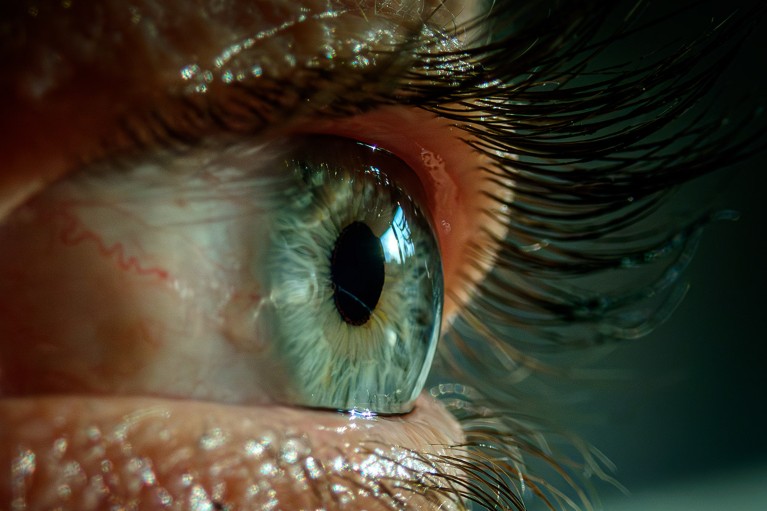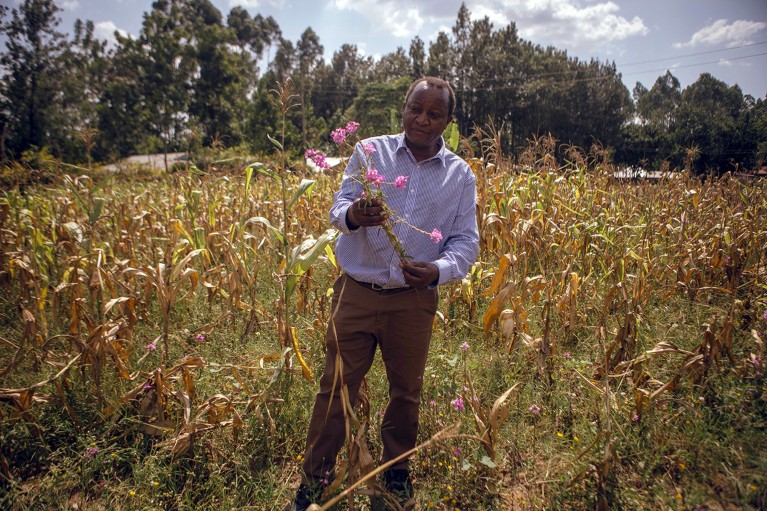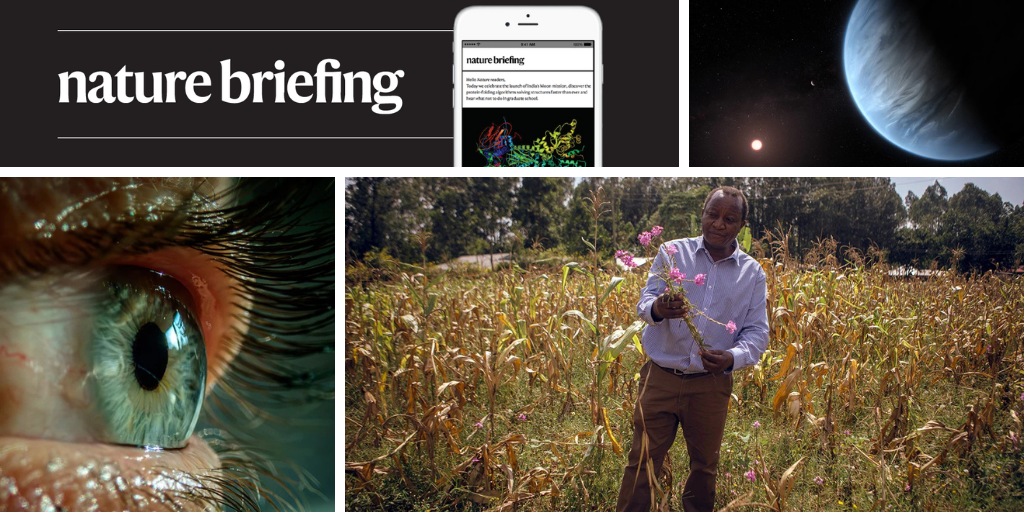You have full access to this article via your institution.
Hello Nature readers, would you like to get this Briefing in your inbox free every day? Sign up here.

Researchers used lasers to stimulate individual cone cells in the retina — leading to the perception of a completely new colour.Credit: George Pachantouris/Getty
Five lucky people have been able to perceive a colour that no one else has ever seen. Researchers used lasers and tracking technology to selectively activate certain cells in their retinas with precise doses of light, to spoof the signals the brain uses to interpret colour. The new shade — named ‘olo’ by the team — is a blue-greenish hue similar to peacock blue or teal. “But the level of saturation is off-the-charts,” says computer scientist Ren Ng, who was a co-author of the study and one of the test participants.
Reference: Science Advances paper
Last week, astronomers announced that they had found the “strongest hints yet of biological activity outside the Solar System”: signs of gases produced by living things in the atmosphere of a distant planet called K2-18 b. Their claim nabbed a spot as our ‘quote of the day’ on Thursday — but some researchers aren’t convinced. Modelling studies suggest that K2-18 b is a barren ‘mini-Neptune’ and the signal teased out of James Webb Space Telescope (JWST) data might be spurious. The measurement is “really pushing the limit of what JWST can do”, says astronomer Laura Kreidberg.
Reference: The Astrophysical Journal Letters paper
Scholarly journals are being purchased from reputable publishers and turned into predatory, low-quality publications by ‘journal snatchers’. An analysis by research-integrity sleuths identified 36 titles bought by what they describe as a network of recently established international companies with no track record in the publishing industry. After the takeover, the journals introduced or raised article-processing charges and started to churn out more studies — practices associated with predatory publishing. In light of the study, citation database Scopus has decided to stop indexing all 36 journals, and Web of Science has delisted 17.
Reference: Zenodo preprint (not peer reviewed)
Adolescents who sleep a bit longer — and go to bed a little earlier — than their peers tend to have improved brain function and perform better at cognitive tests. That’s the result of a study that included more than 3,200 11- and 12-year-olds who were given Fitbit health trackers — heading off the inaccuracies that can come with self-reporting — plus more than a thousand 13-14-year-olds. “Even though the differences in the amount of sleep that each group got was relatively small, at just over a quarter-of-an-hour between the best and worst sleepers, we could still see differences in brain structure and activity and in how well they did at tasks,” says neuroscientist and study co-author Barbara Sahakian.
Reference: Cell Reports paper
Features & opinion
Potatoes grace the tables of something like 1 billion people, but it is fiendishly hard to breed new varieties of the crop because of its ‘tetroploid’ nature: it has four sets of chromosomes. “We have mostly been using the same varieties in the last, let’s say, 200 years,” biologist Sergio Tusso tells the Nature Podcast. He and his colleagues have now generated the ‘pangenome’ of European potatoes, revealing the genetic bottlenecks that occurred during the crop’s journey from South America and spikes of sequence diversity from historical genetic exchanges with wild potato species. This understanding could someday help us to breed or even genetically engineer spuds that are more resistant to diseases and drought.
Nature Podcast | 32 min listen
Reference: Nature paper or go ‘behind the paper’ in this technical, but very readable, post written by four of the study’s authors.
Subscribe to the Nature Podcast on Apple Podcasts, Spotify or YouTube Music, or use the RSS feed.
Last June, journalist Willem Marx was invited onboard a vessel hired by an enigmatic company called Deep Sea Mining Finance (DSMF), which was engaged in exploratory deep-sea mining in the waters surrounding Papua New Guinea. “The more I learned about the endeavor, the more surprised I became about the project’s very existence,” writes Marx. “Scientists have warned that these efforts risk destroying unique deep-sea habitats that we do not yet fully understand, and governments have been reluctant to grant exploration licenses in their territorial waters. But from what I saw during my two days and one night onboard the Coco, DSMF was digging in, and a new era of deep-sea mining had all but begun.”
Scientific American | 19 min read (intermittent paywall)
Where I work

Henry Sila Nzioki is a plant pathologist at the Kenya Agriculture and Livestock Organization in Machakos.Credit: Kang-Chun Cheng for Nature
Plant pathologist Henry Sila Nzioki works to find a sustainable way to control a parasitic weed called Striga, which can devastate farmers’ harvests in Kenya. Since 2008 he’s focused on using a fungus that kills Striga without harming crops. “We still face challenges,” he says. “Many seeds in Kenya are treated with fungicides that might kill our helpful fungus, and getting approval for less harmful, natural pesticides takes years. Most importantly, we need farmers to understand and accept this solution.” (Nature | 3 min read)
Last week’s penguin-seeking puzzle took our friend Leif Penguinson to Dimosari Gorge in southern Greece. Did you find the penguin? When you’re ready, here’s the answer.
As I return from a week’s holiday far from the bright lights of the big city, I am delighted to plunge into the celebration of International Dark Sky Week. If you fancy heading out for some stargazing, there are more than 200 spots in 22 countries that are certified ‘dark sky places’ — search for your closest here. Don’t forget to turn off the lights on your way out.
Thanks for reading,
Flora Graham, senior editor, Nature Briefing
With contributions by Jacob Smith
Want more? Sign up to our other free Nature Briefing newsletters:
• Nature Briefing: Careers — insights, advice and award-winning journalism to help you optimize your working life
• Nature Briefing: Microbiology — the most abundant living entities on our planet — microorganisms — and the role they play in health, the environment and food systems
• Nature Briefing: Anthropocene — climate change, biodiversity, sustainability and geoengineering
• Nature Briefing: AI & Robotics — 100% written by humans, of course
• Nature Briefing: Cancer — a weekly newsletter written with cancer researchers in mind
• Nature Briefing: Translational Research — covers biotechnology, drug discovery and pharma


